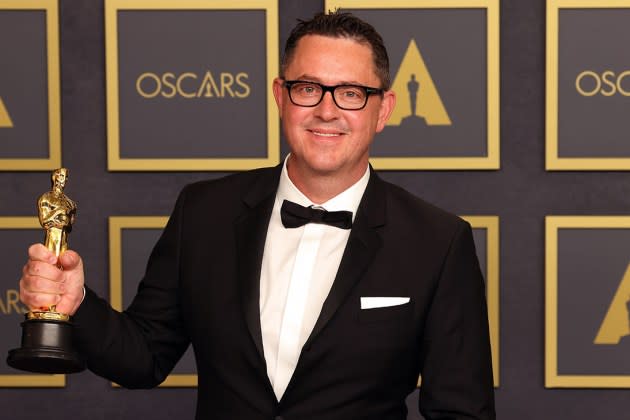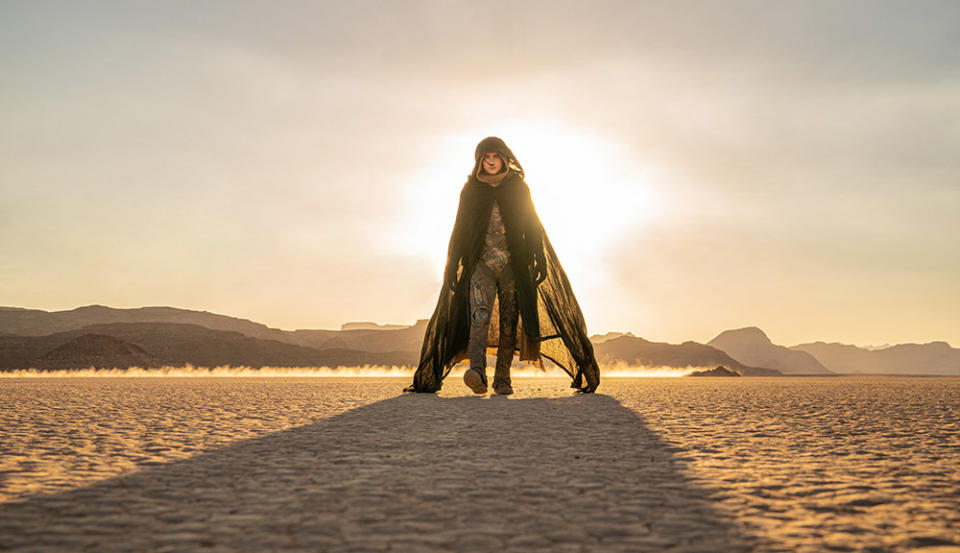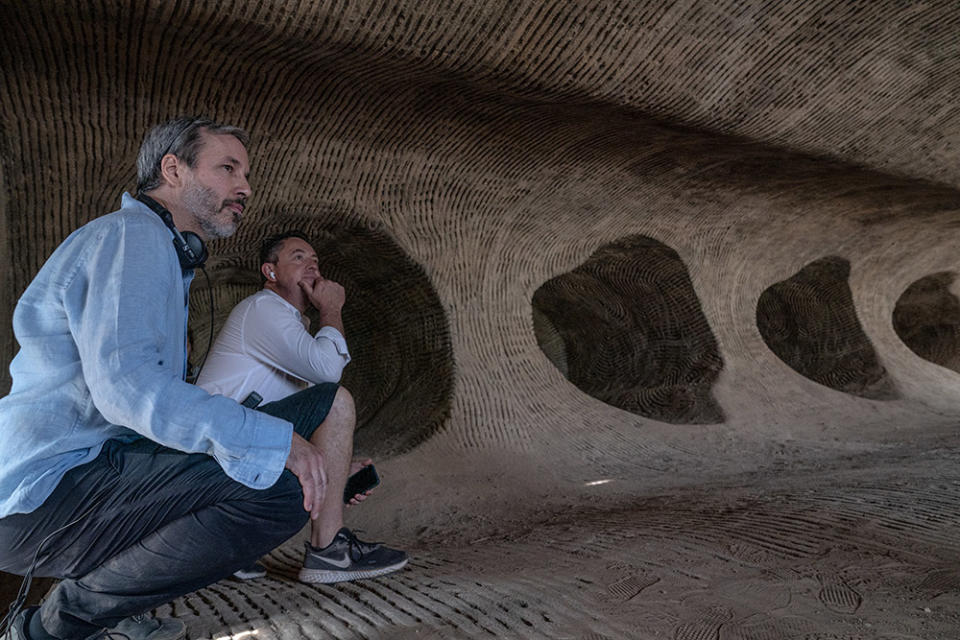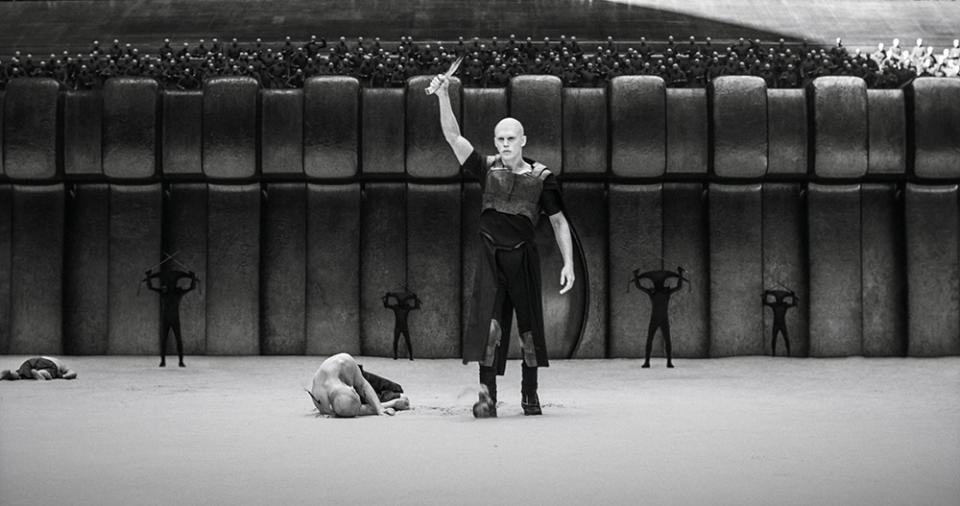‘Dune: Part Two’ DP Greig Fraser on Why He Didn’t Read the Novel and Concerns Over Black-and-White Trend
- Oops!Something went wrong.Please try again later.
- Oops!Something went wrong.Please try again later.

Nearly a decade ago, Oscar-winning cinematographer Greig Fraser was hanging out at one of Roger and James Deakins’ famous barbecues when he was introduced to a French-Canadian man he didn’t immediately recognize. But as soon as he put a face to the name “Denis Villeneuve,” he instantly called to mind two of the filmmaker’s critically acclaimed Canadian films, Polytechnique (2009) and Incendies (2010), as well as his American debut, Prisoners (2013), that he shot with the co-host of that day’s festivities, Roger Deakins. So Fraser and Villeneuve got to know each other that day, before going their separate ways for a few years.
During the intervening time period, Fraser photographed a handful of projects including the first Star Wars spinoff film, Rogue One (2016), as well as the first live-action Star Wars series in The Mandalorian. And then, in 2018, Villeneuve reached out regarding the DP position on his forthcoming adaptation of Frank Herbert’s epic sci-fi novel, Dune (1965), which Fraser gladly accepted, but not without reservation. After all, he had just filmed two Star Wars projects, and that’s a franchise that has long worn its Dune influences on its sleeve. Villeneuve was also planning to shoot desert sequences in Jordan’s Wadi Rum valley, something Fraser did on Rogue One.
More from The Hollywood Reporter
Babs Olusanmokun Talks 'The Ministry of Ungentlemanly Warfare' and a 'Dune 2' Surprise
Stephen McKinley Henderson Talks 'Civil War' Timelessness and "Faithful" 'Dune: Part Two' Story
So the Australian director of photography developed a plan to keep his collaboration with Villeneuve as unadulterated as possible.
“I was worried that [Star Wars] was going to be a hang-up for me. I didn’t sense that Denis had any concerns about that, but the way that I resolved it and solved it was that I didn’t read the [Dune] book. I also didn’t see anything that was related to anyone else’s version of [Dune],” Fraser tells The Hollywood Reporter in support of Dune: Part Two’s Blu-ray release. “I only spoke to Denis and read the script and developed a look with him, so it felt like a very clean and very honest way of developing the film. It didn’t feel like it was drawing upon anything else that existed in the universe or in someone else’s universe or in anything that either of us had done.”
But that doesn’t mean that Fraser ruled out options that happened to overlap with Rogue One.
“I didn’t deliberately do anything that was different [from Rogue One]. There was not a conscious decision to not do something because it was done on Rogue,” Fraser says.
In recent years, a number of films have renewed the long-established practice of alternating between scenes in color and black and white, and the partial list includes: Oppenheimer, Poor Things, Maestro, Asteroid City and Belfast. So when it came time to introduce Feyd-Rautha Harkonnen (Austin Butler), Paul Atreides’ (Timothée Chalamet) primary adversary in Dune: Part Two, Villeneuve took the audience to the Harkonnen homeworld of Giedi Prime where Feyd celebrated his birthday with a little gladiatorial bloodshed. The showstopping sequence in front of a ruckus crowd is also presented in black and white, not just as a stylistic choice, but a narrative one, as Giedi Prime is lit by a black sun, affecting the psyche of its inhabitants.
Recognizing that a black-and-white sequence would fall in line with current tendencies among other films, Fraser admits that the Dune: Part Two creative team had to have an honest talk about the choice.
“The reality is that it can be seen as a trend, and that sucks as a filmmaker. If, suddenly, there’s a creative reason to shoot on black and white, I may think twice about it [now] because it feels like a trend. It feels like you’re doing it just because it’s been done on Oppenheimer or Poor Things or Belfast,” Fraser admits. “When we talked first about Giedi Prime’s sun having no color, we were effectively talking about shooting in black and white, and we asked ourselves that question: ‘Is it a crutch? Is it a trend? Is it a thing if we did it in black and white?’ And, yeah, it’s unfortunate … It can feel like everyone’s doing it, and it can feel a little bit self-conscious because of that.”
Below, during a recent conversation with THR, Fraser also discusses how Dune: Part Two took a page out of the playbook of his other recent film, The Creator, which marked a reunion with Rogue One director, Gareth Edwards.
So part of your job is being versatile in the number of looks that you can achieve at the same location, but were you ever worried that your past Star Wars experiences, such as shooting Rogue One in the same Jordanian desert as Dune, would be a hang-up for Denis?
I wasn’t worried that it was going to be a hang-up for Denis; I was worried that it was going to be a hang-up for me. I didn’t sense that Denis had any concerns about that, but the way that I resolved it and solved it was that I didn’t read the [Dune] book. I also didn’t see anything that was related to anyone else’s version of [Dune]. I only spoke to Denis and read the script and developed a look with him, so it felt like a very clean and very honest way of developing the film. It didn’t feel like it was drawing upon anything else that existed in the universe or in someone else’s universe or in anything that either of us had done.
So it’s a great question because the reality is that I shot Rogue One in Jordan, and then we shot Dune in Jordan. There are obviously similarities between them. We won’t get into it, but there are similarities between the worlds. So I didn’t deliberately do anything that was different [from Rogue One]. There was not a conscious decision to not do something because it was done on Rogue. I feel like I worked with Denis on his version of [Dune], and it was different enough from anything else that was out there so that it would stand on its own legs and have its own voice. And I am pretty proud of the fact that it didn’t change the perception of Rogue One for me or for other people. It had a different voice, and that’s the upshot.

I enjoy your regular appearances on Roger and James Deakins’ podcast. It wasn’t that they recommended you to Denis; it was more that you and Denis connected with each other at their house?
Yeah, that’s where I met Denis for the first time, and I think they had just come off of shooting Sicario. But I don’t know if that barbecue got me the job. I don’t think that was the case. I think Denis had seen some work that I had done. But we met there for the first time, and it was quite fortuitous. I had no idea who Denis was at all, but I knew his work. So when they introduced me to him, I went, “Oh, Denis Villeneuve! He did Incendies. He did Polytechnique. He did Prisoners.” At that point, Prisoners was out, and I became a bit starstruck. So that’s a classic Hollywood story of being at someone else’s barbecue and meeting someone super interesting who you’d then make films with for five years of your life.

When The Creator came out and made headlines for its cost-effective scope and scale, the main question I had for Gareth Edwards was whether these $200 million-budgeted films could cut costs by adopting the same lean-and-mean approach. And he seemed to think it was possible. So do you think you could actually apply that methodology to a Denis Villeneuve Dune movie?
Well, it’s funny because we did apply that to this film. As an audience and as a marketing exercise, you don’t necessarily see the way that we structured this film. By the way, what I loved about The Creator — and part of the reason why I was so passionate about making that with Gareth — is because we wanted to make something where we knew we could really skimp down on the amount of people that we needed to make the movie. Often, on a film set, there are people helping other people, who are helping other people and helping other people. It’s a machine, and it can become a little bit bloated. So Gareth and I were all about making sure it was super small, but on Dune: Part Two, when we were in Abu Dhabi and Jordan, we would also do a small unit in the morning for sunrise.
Ten of us would get up and shoot a scene, and then we’d go to the real set at eight o’clock or nine o’clock in the morning to shoot the harvester attack sequence as the highlight in the heat of the day. And then, at four o’clock in the afternoon, as we waved goodbye to the entire crew that were required to make a very complicated scene like the harvester sequence, we would then go up and shoot a small little intimate scene on a dune or hilltop. So we actually had the best of both worlds where we were able to work with a really small little unit for the scenes that were appropriate to it, but then we had the resources to be able to blow up ornithopters and move massive rigs around the desert and create massive shadows. So it was the best of both worlds where we were able to leverage what we knew about big filmmaking and little filmmaking, and combine those two in the same movie.

The Giedi Prime sequence has an in-universe reason for being black and white, and while this blend of styles has been done throughout cinema history, a number of films lately have revived the practice of using both black and white and color: Oppenheimer, Poor Things, Maestro, Belfast, etc. Do you have any theories as to why it’s such a renewed trend of late?
No, but you hit upon something which is unfortunate. The reality is that it can be seen as a trend, and that sucks as a filmmaker. If, suddenly, there’s a creative reason to shoot on black and white, I may think twice about it [now] because it feels like a trend. It feels like you’re doing it just because it’s been done on Oppenheimer or Poor Things or Belfast. It has been done with such prevalence, and sometimes it means you might go, “Ooh, should we be doing this?”
When we talked first about Giedi Prime’s sun having no color, we were effectively talking about shooting in black and white, and we asked ourselves that question. We said, “Alright, there’s a number of things we can point to …” This was before Oppenheimer and Poor Things had come out, but prior to that, there were some other films that we pointed to and went, “Is it a crutch? Is it a trend? Is it a thing if we did it in black and white?” And, yeah, it’s unfortunate. Shooting in color is not a trend; it’s just the way it is. But, unfortunately, because you’re shooting in black and white, it can be seen as being a trend. So it’s a tricky one, and I’m with you. It can feel like everyone’s doing it, and it can feel a little bit self-conscious because of that.

My favorite moment in Dune: Part Two is when Chani (Zendaya) and Gurney (Josh Brolin) are both concerned about Paul (Timothée Chalamet) during his sermon, and then as soon as Paul pulls out his father’s ducal signet ring, Gurney instantly drinks the Kool-Aid. Do you recall anything about capturing that moment where Gurney becomes a believer?
Yeah, I probably remember every day on Dune: Part Two, and every time you’re pointing a camera at someone like Josh, it’s a heavenly day, because he knows how to turn it on for a camera. I have such high praise for actors, particularly someone like Josh, with all of his experience. He knows exactly how to work the camera to get the best out of it. So it was an amazing performance by an incredible actor.
***
Dune: Part Two is now available on 4K Ultra HD.
Best of The Hollywood Reporter

